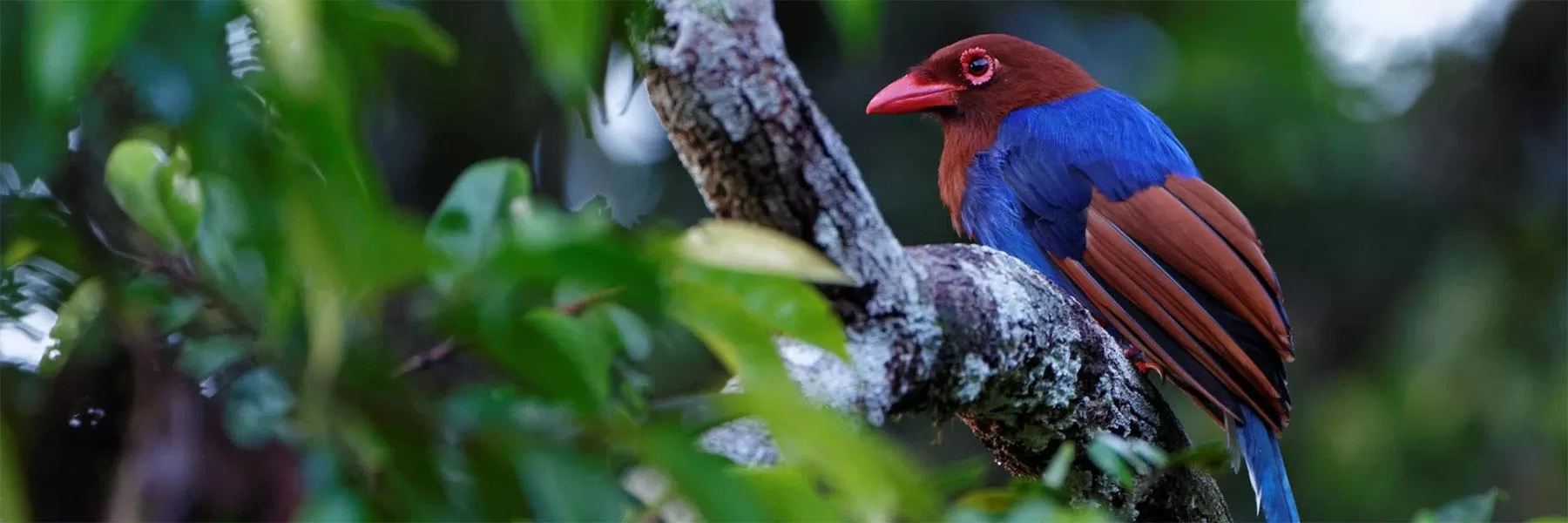Situated off the southern coast of India, Sri Lanka is a large tropical island. Because of its pearl shape, people often refer to the island country as the ‘pearl of the Indian Ocean’. This destination offers one of the best ways to experience the culturally rich Indian subcontinent.
Sri Lanka boasts flourishing flora and fauna. Due to favourable and diverse climatic conditions, avifauna thrives on this island. Sri Lanka has different locations featuring various exotic birds, making it a paradise for avid bird watchers.

Sri Lankan elephants at Minneriya National Park
In Sri Lanka, the total number of bird species amounts to over 430. Out of these, 233 are breeding residents, including 33 species that are recognised as endemic to the country. An additional 200 bird species are migratory birds that visit Sri Lanka as they move away from Siberia, Scandinavia, and Western Europe.

A magpie robin spotted in the town of Mawanella, Sri Lanka
There are suitable habitats for birds like forests, scrublands, grasslands, the sea, wetlands, and agricultural lands in this small island country. A healthy population of birds thrives in these natural habitats, guaranteeing sightings of Sri Lanka’s colourful birds. You can witness bird species such as parrots, parakeets, fowls, malkoha, owls, hornbills, magpies, bulbuls, starlings, flycatchers, swallows, and many more.
Check out the 4 best birding places that showcase the vibrant avifauna of Sri Lanka:
Sinharaja Forest Reserve
The name ‘Sinharaja’ translates to lion kingdom. Sinharaja is one of the most important biodiversity spots in Sri Lanka. It is located approximately three hours away from Sri Lanka’s capital city, Colombo. According to the IUCN, this reserve is the country’s last viable region of primary tropical rainforest. Here, more than 60% of the trees are endemic, and many are even considered rare.

The vast Sinharaja Forest Reserve
Sinharaja Forest Reserve garnered international recognition and was soon declared a world heritage site by UNESCO in 1988. Also known as a national park, it is visited by locals as well as tourists due to its rich flora and fauna.
This tropical evergreen forest has 154 species of birds, including 20 endemic species. Moreover, you can also find mixed-feeding foraging flocks, a term used for a flock of insectivore birds of different species that join each other and move together while foraging.

A tiny crested drongo
The most notable species of birds to admire at Sinharaja Forest Reserve are the orange-billed babbler, crested drongo, green-billed coucal, Sri Lanka white-faced starling, wood pigeon, blue magpie, jungle fowl, and the elusive red-faced malkoha. Other endemic species such as Layard’s parakeet, Ceylon lorikeet, hanging parrot, ashy-headed laughing thrush, and more can be seen in Sinharaja’s tropical forest.
Horton Plains National Park
Horton’s National Park in Ohiya is a highland plateau set at an elevation of 7500 ft above sea level. Horton’s National Park, along with the Knuckles Conservation Forest and the Peak Wilderness, are protected areas of Sri Lanka’s highlands that were declared a world heritage site in 2006.

The picturesque Horton Plains National Park
Horton Plains are located on the southern plateau of Sri Lanka’s central highlands and have a rich biodiversity. Among the distinctive mammals such as Sambar deer, Sri Lankan leopard, toque macaque, and the endangered red slender loris, Horton Plains is an important birding site as well.
One of the most beautiful birding spots is this national park, surrounded by towering mountains, clear streams, and colorful blooms.

Sri Lanka junglefowl, the national bird of Sri Lanka
The plains contain 21 endemic bird species, such as the Sri Lanka bush warbler, spurfowl, dull blue flycatcher, white-eyed hawk, and the junglefowl, Sri Lanka’s national bird. You can also enjoy sightings of a variety of migratory birds in Horton Plains, like the crested serpent eagle, alpine swift, black-winged kite, and mountain hawk eagle.
Bundala National Park
Bundala National Park is located in the Southern Province near Hambantota. It was declared a national park in Sri Lanka in 1993. Bundala also became the first wetland in the country to be classified as a Ramsar site in 1991.
The landscape of this national park consists of thorny scrubland marshes, waterways, and dunes. Additionally, the wealth of brackish-water lagoons in the park makes it an appealing destination for migratory birds.

Flock of cranes near a river in Bundala National Park
Bundala boasts around 200 bird species, of which 150 are endemic and the rest are migratory. One of the most famous highlights is the flock of over 1,000 greater flamingos that travel from India’s Raan of Kutch to Bundala. Other migratory birds include petite blue-tailed bee-eaters, brown flycatchers, barn swallows, waterfowl, and many more. In the park, visitors can also spot endemic birds like the brown-capped babbler, the Ceylon wood shrike, and junglefowl.

A cormorant rests near the Madu Ganga River
Aside from pink flamingos, there are many migratory aquatic and resident water birds in Bundala, namely painted storks, ibis, terns, herons, egrets, cormorants, and more.
Kitulgala Forest Reserve
The Kitulgala Forest Reserve is a secondary lowland rainforest that is gradually moving towards higher elevations. It is located near the serene village of Kitulgala and is home to the famous Kelani River. It is one of the wettest places in Sri Lanka, as it receives two monsoons each year.
Also known as the Makandawa Forest Reserve. This region is slowly exploding with a rich ecosystem and is considered a hidden treasure spot in Sri Lanka.

The green Kitulgala forest reserve
In addition to scenic waterfalls, this forest reserve has diverse flora and fauna. It is the best place to spot lowland bird species. There are 54 rare endemic species of birds in the reserve, like the chestnut-backed owlet, green-bill coucal, grey hornbill, yellow-fronted barbet, Ceylon rufous babbler, Sri Lanka crested drongo, and many more. The newly discovered species of Serendip Scops owl was also discovered here, along with the common hill myna.

The brown Ceylon rufous babbler
Numerous migratory birds like the crested goshawk, Basra reed warbler, and mountain hawk-eagle also visit the rainforest.
When is the best time to spot birds in Sri Lanka?
Birding in Sri Lanka can be done all year. However, if you are on the lookout for migratory birds, both terrestrial and aquatic species arrive in September or October and stay until April. On the other hand, you can spot endemic birds until July.
During your trip, keep these birding spots in Sri Lanka in mind to experience the country’s avifauna to the fullest.
If you loved reading this story, then subscribe to our blog here (it will ask to verify your email) to get inspiring travel stories and trivia delivered to your email. Stories about wildlife trivia, cultural experiences, curated luxury hotel lists, underrated places to travel, polar journeys and much more.











